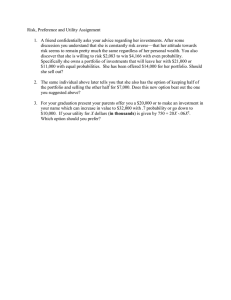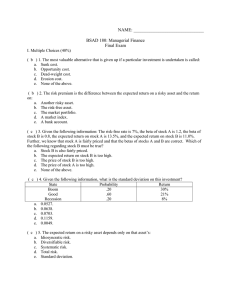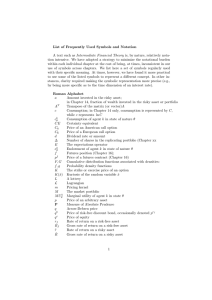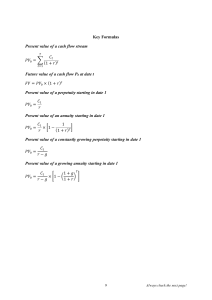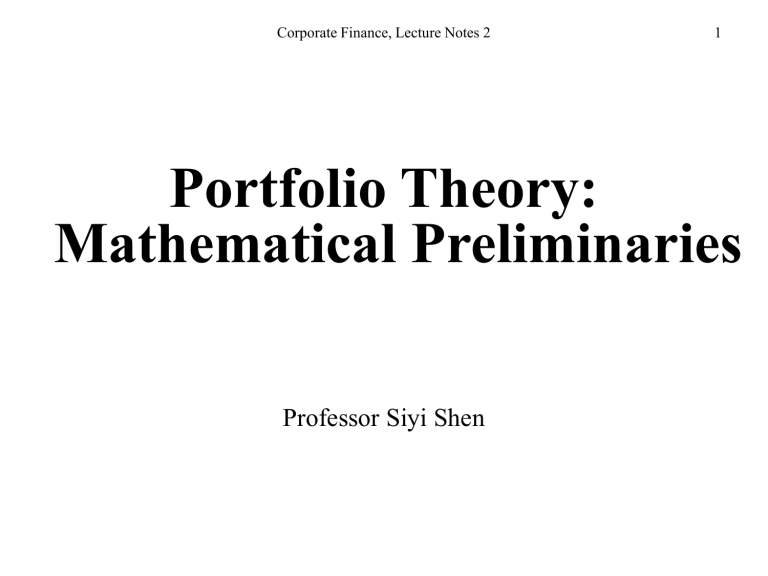
Corporate Finance, Lecture Notes 2 1 Portfolio Theory: Mathematical Preliminaries Professor Siyi Shen Corporate Finance, Lecture Notes 2 2 Introduction ➢ Typically, stocks are not held in isolation but as part of a portfolio. It is overall return and risk of the entire portfolio, which we care about. Therefore, the riskiness of a stock is determined by its contribution to the overall risk of the portfolio. ➢ Therefore, the risk premium of a stock would be a function of the undiversifiable risk of the stock. Corporate Finance, Lecture Notes 2 3 Probability Distribution ➢ In probability and statistics, a random variable is a variable whose values depend on outcomes of a random phenomenon (e.g., AAPL’s stock return next year). ➢ The set of all possible values of a random variable, with their associated probabilities, is called the probability distribution of the random variable. All possible outcomes are assigned values and probabilities, and thus the probabilities are non-negative and must sum to 1. Corporate Finance, Lecture Notes 2 4 Expected Returns ➢ Suppose there are S possible states, and let us denote each possible state as i, i = 1, 2, 3, …, S. ➢ The probability of the state s being realized is denoted as pi. These states should be exclusive outcomes, i.e. only one of the possible states i can occur. Further, these S states should exhaust all possible outcomes. Thus these probabilities sum to 1. ➢ Consider a risky asset whose rate of return in each of these possible S states are r1, r2, r3, …, rS. The rate of return on this risky asset can be viewed as a random variable. ➢ The expected return E(r) of an asset is the probability weighted average return in all scenarios S E[r ] = p1r1 + .... + pS rS = pi ri i =1 Corporate Finance, Lecture Notes 2 5 Measures of Risk: Variance and Standard Deviation ➢ What is a good measure of risk? ➢ We define the variance, a measure of risk, as the expected squared deviation of the rate of return from its expectation: S [r ] = E[r − E[r ]] = pi [ri − E[r ]] 2 2 2 i =1 ➢ To transform the variance into units of percentage return, we take the square root of the variance, which gives us the standard deviation. Spring 2009 Corporate Finance, Lecture Notes 2 6 Example 1 ➢ Consider the following probability distributions of the returns on XYZ Corp. and ABC Corp. Calculate the expected returns and variances. XYZ ABC Outcome Probability Value Value Boom 0.2 30% 60% Normal 0.7 10% 10% Recession 0.1 -20% -40% Corporate Finance, Lecture Notes 2 7 Measures of Association: Covariance and Correlation ➢ The covariance between returns is a measure of co-movement. The covariance between stock A and stock B is defined as: cov[rA , rB ] = E[rA − E[rA ]][rB − E[rB ]] = S = pi [ rA,i − E[ rA ]][ rB ,i − E[ rB ]] i =1 ➢ Calculate the covariance between XYZ Corp. and ABC Corp. Corporate Finance, Lecture Notes 2 8 Measures of Association: Covariance and Correlation – Cont’d ➢ How close do stocks move together? The correlation coefficient provides the degree of intensity of the co-movement. The correlation coefficient between the returns of stock A and stock B is defined as: A, B = cov[rA , rB ] A B ➢ Calculate the correlation between XYZ Corp. and ABC Corp. Corporate Finance, Lecture Notes 2 9 Basic Properties of Random Variables ➢ Consider random variables X and Y, and some constants a and b. Expectation E (a + X ) = a + E ( X ) E (aX ) = aE ( X ) E ( X + Y ) = E ( X ) + E (Y ) E (aX + bY ) = aE ( X ) + bE (Y ) Variance Var(a + X ) = Var( X ) Var(aX ) = a 2Var( X ) Cov(aX , bY ) = abCov( X , Y ) Var(aX + bY ) = a 2Var( X ) + b 2Var(Y ) + 2abCov( X , Y ) Corporate Finance, Lecture Notes 2 10 Application to Portfolios ➢ Assume that the random variables X and Y correspond to the returns of two risky assets, say rA and rB. The constants a and b correspond to portfolio weights, say wA and wB. If you combine these two assets into a portfolio P with the weights wA and wB, then the expected return and variance of the portfolio are: E (rp ) = E (wA rA + wB rB ) = wA E (rA ) + wB E (rB ) Var(rp ) = Var(wA rA + wB rB ) = wA2Var(rA ) + wB2Var(rB ) + 2wA wB Cov(rA , rB ) Corporate Finance, Lecture Notes 2 11 Diversification with 2 Assets - Example • Suppose we have two assets, US and JP, with: mean volatility US E[R1]=13.6% σ1=15.4% JP E[R2]=15.0% σ2=23.0% and with correlation ρ12=27%. • If an investor holds w1=60% in the US and w2=40% in JP what is the mean and volatility of the portfolio? Corporate Finance, Lecture Notes 2 12 Risk, Return, and the Mean-Variance Criterion Corporate Finance, Lecture Notes 2 13 Risk-Return Tradeoff - Introduction ➢ Suppose you could pick one of the stocks in each figure. Which one would you pick? 1.2 0.6 1.2 1 1 0.5 0.8 0.8 0.4 0.6 0.6 0.3 0.4 0.2 0.2 0.4 0.2 0 0.1 0 -0.2 0 -0.2 -0.4 -0.1 0 5 10 15 20 25 30 35 40 45 50 -0.6 -0.4 0 5 10 15 20 25 30 35 40 45 50 0 5 10 15 20 25 30 35 40 45 Mean 0.15 0.35 Mean 0.20 0.20 Mean 0.20 0.40 Stdev 0.10 0.10 Stdev 0.10 0.40 Stdev 0.10 0.40 50 Corporate Finance, Lecture Notes 2 Risk-Return Tradeoff • Recall two of the Finance Axioms: – Investors prefer more to less – Investors are risk-averse • This means that investors prefer an investment : – with a higher expected return E(Ri) – with a lower variance and standard deviation, i • Investors must optimally tradeoff risk and return in order to maximize their expected utility. 14 Corporate Finance, Lecture Notes 2 Indifference Curves: Review • A person likes 2 goods: bread (B) and chocolate (C). • An indifference curve gives all the combinations of B and C that give the same utility level U0 = U(B,C). • People like to be on the highest possible indifference curve (people prefer more to less). B U0 C 15 Corporate Finance, Lecture Notes 2 16 Indifference Curves in Finance Indifference curve: A set of (E(Rp),p) combinations that give an investor the same expected utility 0.45 High utility 0.4 Medium utility 0.35 Low utility Exp. Return 0.3 0.25 Series1 Series2 Series3 0.2 0.15 0.1 0.05 0 0 0.05 0.1 0.15 0.2 Standard Deviation 0.25 0.3 0.35 Corporate Finance, Lecture Notes 2 17 Risk Aversion and Utility ➢ A simple, widely used form of utility function (quadratic) is: U = E(r) – 0.5A2 ➢ What is A? Risk aversion coefficient ➢ What are we assuming about the distribution of returns? Corporate Finance, Lecture Notes 2 18 Mean-Variance Criterion ➢ The mean-variance criterion is defined as follows: For a risk averse, expected utility maximizing investor, Asset A dominates Asset B: if E(rA) E(rB) and A2 < B2 or if E(rA) > E(rB) and A2 B2 Corporate Finance, Lecture Notes 2 19 Asset Allocation across Risky and Risk-Free Portfolios Corporate Finance, Lecture Notes 2 20 Introduction ➢ Asset allocation decision refers to a choice among broad investment classes, such as stocks, long-term T-bonds, and short-term T-bills. ➢ In this section, we shall study the most basic asset allocation choice: the choice of how to allocate one’s investment fund between risk-free securities and risk asset classes. Corporate Finance, Lecture Notes 2 21 Example 1 ➢ Suppose a portfolio of risky stocks P is your “optimal” risky portfolio (we shall discuss what it means to be optimal later). E(rp)=15%, and p=22%. The risk-free rate of return rf (T-bill rate) is 7%. You have $1,000 to invest and want 12% expected return for your investment. How should you combine the portfolio P and the risk-free asset? ➢ What is the standard deviation of the return on your investment? Corporate Finance, Lecture Notes 2 22 Example 1 – Cont’d ➢ Suppose you think the standard deviation of 13.75% is too risky, and want 10% standard deviation of return for your investment. What should be the allocation in this case? What is the expected return of this portfolio? Corporate Finance, Lecture Notes 2 23 Capital Allocation Line (CAL) ➢ In addition to the two particular allocation choices above, we can examine the risk-return combinations of all possible allocation choices. Weight Portfolio P 0 0.1 0.2 0.3 0.4 0.5 0.6 0.7 0.8 0.9 1 1.1 1.2 1.3 1.4 Weight T-Bill 1 0.9 0.8 0.7 0.6 0.5 0.4 0.3 0.2 0.1 0 -0.1 -0.2 -0.3 -0.4 Expected Standard Return Deviation 0.07 0 0.078 0.022 0.086 0.044 0.094 0.066 0.102 0.088 0.11 0.11 0.118 0.132 0.126 0.154 0.134 0.176 0.142 0.198 0.15 0.22 0.158 0.242 0.166 0.264 0.174 0.286 0.182 0.308 ➢ The cases where the weight on T-bill is negative are where you borrow at the risk-free rate and invest the borrowed amount in the risky portfolio P. Corporate Finance, Lecture Notes 2 24 Capital Allocation Line – Cont’d ➢ The Capital Allocation Line (CAL) is simply a plot of these combinations in a mean-standard deviation space: CAL depicts the risk-return combinations available by varying asset allocation between a risk-free asset and a risky portfolio. Capital Allocation Line 0.2 0.18 0.16 Expected return 0.14 0.12 0.1 0.08 0.06 0.04 0.02 0 0 0.05 0.1 0.15 0.2 Standard deviation 0.25 0.3 0.35 Corporate Finance, Lecture Notes 2 25 Sharpe Ratio ➢ The slope of the CAL, called the Sharpe ratio (or reward-to-risk ratio), equals the increase in expected return that can be obtained per unit of additional standard deviation. It is a measure of the riskreturn trade-off (extra return per extra risk), and is give by S= E (rp ) − r f p ➢ Thus, the Sharpe ratio is a ratio of risk premium to standard deviation. Corporate Finance, Lecture Notes 2 26 Risk Aversion, Utility ➢ Given all the choices on the CAL, what is the optimal allocation for the investor? What is the allocation that provides the highest expected utility? ➢ Recall our representative investor’s preferences provided by the utility function U = E(r) – 0.5A2 ➢ We can calculate and plot the utility levels as a function of the weight on the risky portfolio P as follows. 0.1 0.09 0.08 0.07 Utility 0.06 0.05 0.04 0.03 0.02 0.01 0 0 0.1 0.2 0.3 0.4 0.5 0.6 Weight on the risk portfolio P A=4 A=6 0.7 0.8 0.9 1

